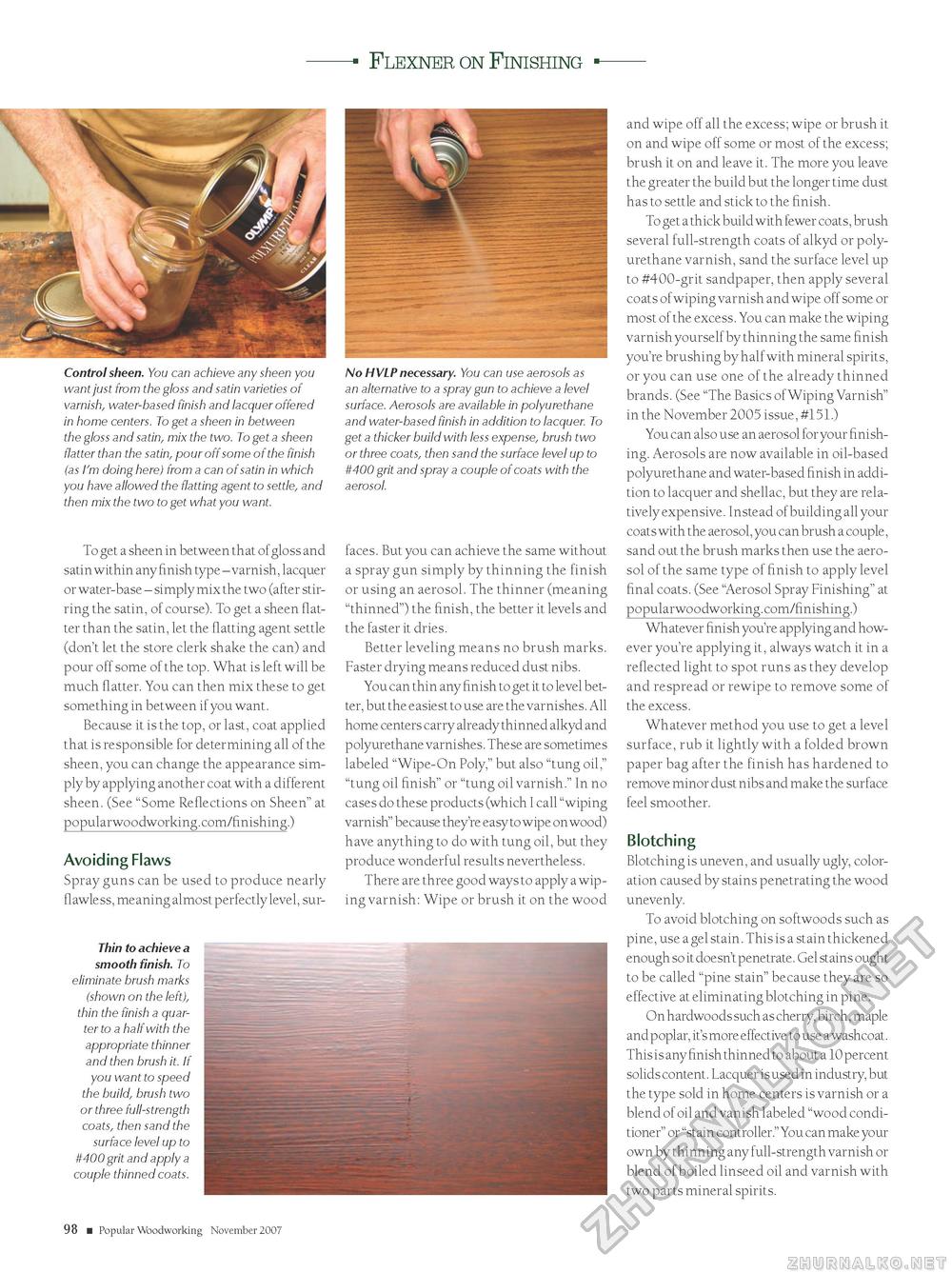Popular Woodworking 2007-11 № 165, страница 100
Flexner on Finishing Control sheen. You can achieve any sheen you want just from the gloss and satin varieties of varnish, water-based finish and lacquer offered in home centers. To get a sheen in between the gloss and satin, mix the two. To get a sheen flatter than the satin, pour off some of the finish (as I'm doing here) from a can of satin in which you have allowed the flatting agent to settle, and then mix the two to get what you want. To get a sheen in between that of gloss and satin within any finish type - varnish, lacquer or water-base - simply mix the two (after stirring the satin, of course). To get a sheen flatter than the satin, let the flatting agent settle (don't let the store clerk shake the can) and pour off some of the top. What is left will be much flatter. You can then mix these to get something in between if you want. Because it is the top, or last, coat applied that is responsible for determining all of the sheen, you can change the appearance simply by applying another coat with a different sheen. (See "Some Reflections on Sheen" at popularwoodworking.com/finishing.) Avoiding Flaws Spray guns can be used to produce nearly flawless, meaning almost perfectly level, sur- Thin to achieve a smooth finish. To eliminate brush marks (shown on the left), thin the finish a quarter to a half with the appropriate thinner and then brush it. If you want to speed the build, brush two or three full-strength coats, then sand the surface level up to #400 grit and apply a couple thinned coats. No HVLP necessary. You can use aerosols as an alternative to a spray gun to achieve a level surface. Aerosols are available in polyurethane and water-based finish in addition to lacquer. To get a thicker build with less expense, brush two or three coats, then sand the surface level up to #400 grit and spray a couple of coats with the aerosol. faces. But you can achieve the same without a spray gun simply by thinning the finish or using an aerosol. The thinner (meaning "thinned") the finish, the better it levels and the faster it dries. Better leveling means no brush marks. Faster drying means reduced dust nibs. You can thin any finish to get it to level better, but the easiest to use are the varnishes. All home centers carry already thinned alkyd and polyurethane varnishes. These are sometimes labeled "Wipe-On Poly," but also "tung oil," "tung oil finish" or "tung oil varnish." In no cases do these products (which I call "wiping varnish" because they're easy to wipe on wood) have anything to do with tung oil, but they produce wonderful results nevertheless. There are three good ways to apply a wiping varnish: Wipe or brush it on the wood and wipe off all the excess; wipe or brush it on and wipe off some or most of the excess; brush it on and leave it. The more you leave the greater the build but the longer time dust has to settle and stick to the finish. To get a thick build with fewer coats, brush several full-strength coats of alkyd or poly-urethane varnish, sand the surface level up to #400-grit sandpaper, then apply several coats of wiping varnish and wipe off some or most of the excess. You can make the wiping varnish yourself by thinning the same finish you're brushing by half with mineral spirits, or you can use one of the already thinned brands. (See "The Basics of Wiping Varnish" in the November 2005 issue, #151.) You can also use an aerosol for your finishing. Aerosols are now available in oil-based polyurethane and water-based finish in addition to lacquer and shellac, but they are relatively expensive. Instead of building all your coats with the aerosol, you can brush a couple, sand out the brush marks then use the aerosol of the same type of finish to apply level final coats. (See "Aerosol Spray Finishing" at popularwoodworking.com/finishing.) Whatever finish you're applying and however you're applying it, always watch it in a reflected light to spot runs as they develop and respread or rewipe to remove some of the excess. Whatever method you use to get a level surface, rub it lightly with a folded brown paper bag after the finish has hardened to remove minor dust nibs and make the surface feel smoother. Blotching Blotching is uneven, and usually ugly, coloration caused by stains penetrating the wood unevenly. To avoid blotching on softwoods such as pine, use a gel stain. This is a stain thickened enough so it doesn't penetrate. Gel stains ought to be called "pine stain" because they are so effective at eliminating blotching in pine. On hardwoods such as cherry, birch, maple and poplar, it's more effective to use a washcoat. This is any finish thinned to about a10 percent solids content. Lacquer is used in industry, but the type sold in home centers is varnish or a blend of oil and vanish labeled "wood conditioner" or "stain controller." You can make your own by thinning any full-strength varnish or blend of boiled linseed oil and varnish with two parts mineral spirits. 98 ■ Popular Woodworking November 2007 |








